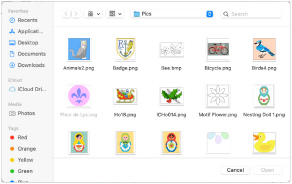Use Manage My Fills to load new pictures for fill patterns, export an existing My Fill pattern as a picture and delete unwanted My Fills. 
Note: If you have a design using a My Fill pattern and give it to a friend, it is likely that their My Fill database will have different patterns to your My Fill database. Export the My Fill pattern and give the picture to your friend to import into their My Fill database.
To Select Manage My Fills
-
Choose Edit > Manage My Fills.
Export
Use Export to save a My Fill pattern as a picture. The picture can then be copied and imported into a friend’s My Fills.
To Export a Picture from My Fills
-
Click Export. In the save dialog the file name is automatically set to the number used for the pattern in your My Fills.

The following file formats may be saved: Windows or OS2 Bitmap (.bmp), JPEG Low Quality (.jpg), JPEG High Quality (.jpg), Tagged Image File Format uncompressed (.tif) and Portable Network Graphics (.png).
Delete
Use Delete to remove the selected My Fill pattern. Delete can be used to remove unwanted patterns.
Note: When a My Fill pattern is deleted, any designs that used that pattern will use standard Pattern 3 until a new pattern is chosen.
To Delete a Picture from My Fills
-
Select a My Fills pattern, then click Delete. A message appears to ask for confirmation. Click OK to remove the pattern.
Import
Use Import to create a new My Fill based on a picture or a previously exported My Fill. After importing a picture, that fill will be available in the My Patterns ![]() category of the Pattern dialog.
category of the Pattern dialog.
To Import a Picture for a My Fill
-
Click the Import button and in the open dialog select the picture to import, then click Open.
Note: The height and width of the picture must each be from 120 to 700 pixels.

The following file formats may be loaded: Windows or OS2 Bitmap (.bmp), JPEG-JFIF Compliant (.jpg, .jif, .jpeg), Portable Network Graphics (.png), Tagged Image File Format uncompressed (.tiff, .tif), High Efficiency Image Format (.heic) and Windows Icon (.ico).
Note: The picture is automatically converted to black and white to determine the best positions for stitch points. Therefore, the best results are usually obtained from simple pictures drawn in black and white.
A My Fill pattern is repeated every 0.1mm for each pixel in the source picture. For example, if your picture is 300 x 200 pixels, it is repeated every 30mm horizontally and 20mm vertically if the fill angle is set to 0.
Use a Bee for a My Fill Pattern
-
If required, choose File > New.
-
Choose Edit > Manage My Fills.
-
In the Manage My Fills dialog, click Import and the open picture dialog appears.

-
Browse to the folder /mySewnet/Samples/Digitizing/Pics.
Note: Simple black and white pictures are recommended. The height and width of the picture must be between 120 and 700 pixels. -
Click 'Bee.bmp', then click Open. The bee fill is created and a preview sample is shown in the Manage My Fills dialog.
-
Click Close.
-
Click Point Create
 to open the Point Create toolbar.
to open the Point Create toolbar. -
In the stitch types area choose Pattern Fill and No Border Line. See Select a Stitch Type.

-
Click the Create Point Area or Line
 button. See Create Point Area or Line.
button. See Create Point Area or Line. -
Draw a large circle in the work area. It is filled with Pattern Fill.
-
Control–click the circle in the FilmStrip and choose Properties.
-
Click the Pattern (ellipsis) button to open the Pattern viewer, and scroll down the list to My Patterns. The bee design has automatically been given pattern number 501. Enter this number to go directly to the bee pattern.
Alternatively, click My Patterns . The bee pattern is automatically selected if it is the only pattern.
. The bee pattern is automatically selected if it is the only pattern.
The bee pattern is now displayed in the Area Properties dialog. -
Click OK to close the Area Properties dialog and view the bee fill pattern on your fill.